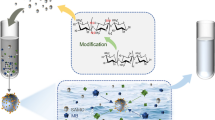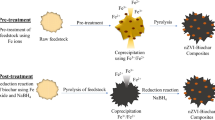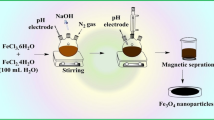Abstract
A novel chitosan/ceria/iron oxide (CS/ceria/Fe3O4) nano-composite adsorbent was synthesized for removal of Cr(VI) and Co(II) ions from aqueous systems in a batch system. The adsorbents were characterized by field emission scanning electron microscopy (FESEM), Fourier transform infrared spectroscopy (FTIR), X-ray diffraction (XRD), transmission electron microscopy (TEM), thermal gravimetric analysis (TGA), and Brunauer- Emmett-Teller (BET) analyses. The behavior of swelling kinetics was also studied. The effect of several adsorption parameters including CeO2 and Fe3O4 contents, initial pH, contact time, initial Cr(VI) and Co(II) concentration, and temperature on the adsorption capacity was studied. The double exponential model revealed a better fit with the kinetic data of Cr(VI) and Co(II) ions. The Cr(VI) and Co(II) adsorption process well fitted the Langmuir model. The maximum adsorption capacities estimated from Langmuir isotherm model were 315.4 and 260.6 mg/g for Cr(VI) and Co(II) ions, respectively. Also, thermodynamic parameters were used to distinguish the nature of Cr(VI) and Co(II) adsorption. The reusability of CS/ceria/Fe3O4 nano-composite was evaluated with stripping agents of 0.1 M NaOH and 0.1 M HNO3. Finally, the evaluation of Cr(VI)-Co(II) coexisting system confirmed that the presence of Co(II) ions played an inhibitor role on the Cr(VI) adsorption.









Similar content being viewed by others
References
Abbasizadeh S, Keshtkar AR, Mousavian MA (2013) Preparation of a novel electrospun polyvinyl alcohol/titanium oxide nanofiber adsorbent modified with mercapto groups for uranium(VI) and thorium(IV) removal from aqueous solution. Chem Eng J 220:161–171
Abbasizadeh S, Keshtkar AR, Mousavian MA (2014) Sorption of heavy metal ions from aqueous solution by a novel cast PVA/TiO2 nanohybrid adsorbent functionalized with amine groups. J Ind Eng Chem 20:1656–1664
Ahmad NF, Kamboh MA, Nodeh HR, Halim SNBA, Mohamad S (2017) Synthesis of piperazine functionalized magnetic sporopollenin: a new organic-inorganic hybrid material for the removal of lead(II) and arsenic(III) from aqueous solution. Environ Sci Pollut Res 24:21846–21858
Ahmadpour A, Tahmasbi M, Bastami TR, Besharati JA (2009) Rapid removal of cobalt ion from aqueous solutions by almond green hull. J Hazard Mater 166:925–930
Bai Y, Bartkiewicz B (2009) Removal of cadmium from wastewater using ion exchange resin Amberjet 1200H columns. Polish J Enviro Stud 18:1191–1195
Becker F, Rodríguez D, Schwab M (2012) Magnetic removal of cobalt from waste water by ferrite co-precipitation. Procedia Mater Sci 1:644–650
Bhatnagar A, Sillanpää M (2009) Applications of chitin- and chitosan-derivatives for the detoxification of water and wastewater—a short review. Adv Colloid Interf Sci 152:26–38
Cao C, Xiao L, Chen C, Shi X, Cao Q, Gao L (2014) In situ preparation of magnetic Fe3O4/chitosan nanoparticles via a novel reduction–precipitation method and their application in adsorption of reactive azo dye. Powder Technol 260:90–97
Chen L-F, Liang H-W, Lu Y, Cui C-H, Yu S-H (2011) Synthesis of an attapulgite clay@ carbon nanocomposite adsorbent by a hydrothermal carbonization process and their application in the removal of toxic metal ions from water. Langmuir 27:8998–9004
Coll M, Fortuny A, Kedari C, Sastre A (2012) Studies on the extraction of Co(II) and Ni(II) from aqueous chloride solutions using Primene JMT-Cyanex272 ionic liquid extractant. Hydrometallurgy 125:24–28
Du G, Li Z, Liao L, Hanson R, Leick S, Hoeppner N, Jiang W-T (2012) Cr(VI) retention and transport through Fe (III)-coated natural zeolite. J Hazard Mater 221:118–123
El-Reash YA, Abdelghany A, Elrazak AA (2016) Removal and separation of Cu(II) from aqueous solutions using nano-silver chitosan/polyacrylamide membranes. Inter J Biol Macromol 86:789–798
Ferfera-Harrar H, Dairi N (2014) Green nanocomposite films based on cellulose acetate and biopolymer-modified nanoclays: studies on morphology and properties. Iranian Polym J 23:917–931
Hallaji H, Keshtkar AR, Moosavian MA (2015) A novel electrospun PVA/ZnO nanofiber adsorbent for U(VI), Cu(II) and Ni(II) removal from aqueous solution. J Taiwan Inst Chem Eng 46:109–118
Ji F, Li C, Tang B, Xu J, Lu G, Liu P (2012) Preparation of cellulose acetate/zeolite composite fiber and its adsorption behavior for heavy metal ions in aqueous solution. Chem Eng J 209:325–333
Kim S, Chu KH, Al-Hamadani YA, Park CM, Jang M, Kim D-H, Yu M, Heo J, Yoon Y (2017) Removal of contaminants of emerging concern by membranes in water and wastewater: a review. Chem Eng J 335:896–914
Kim SJ, Lee KJ, Kim IY, Lee YM, Kim SI (2003) Swelling kinetics of modified poly (vinyl alcohol) hydrogels. J Appl Polym Sci 90:3310–3313
Li X, Gao X, Ai L, Jiang J (2015) Mechanistic insight into the interaction and adsorption of Cr(VI) with zeolitic imidazolate framework-67 microcrystals from aqueous solution. Chem Eng J 274:238–246
Liu C-C, Kuang-Wang M, Li Y-S (2005) Removal of nickel from aqueous solution using wine processing waste sludge. Ind Eng Chem Res 44:1438–1445
Liu J-F, Z-s Z, G-b J (2008) Coating Fe3O4 magnetic nanoparticles with humic acid for high efficient removal of heavy metals in water. Environ Sci Technol 42:6949–6954
Liu W, Zhang J, Jin Y, Zhao X, Cai Z (2015) Adsorption of Pb(II), Cd(II) and Zn(II) by extracellular polymeric substances extracted from aerobic granular sludge: efficiency of protein. J Environ Chem Eng 3:1223–1232
Mirbagheri S, Hosseini S (2005) Pilot plant investigation on petrochemical wastewater treatment for the removal of copper and chromium with the objective of reuse. Desalination 171:85–93
Petrella A, Spasiano D, Acquafredda P, De Vietro N, Ranieri E, Cosma P, Rizzi V, Petruzzelli V, Petruzzelli D (2018) Heavy metals retention (Pb(II), Cd(II), Ni(II)) from single and multimetal solutions by natural biosorbents from the olive oil milling operations. Process Saf Environ Protect 114:79–90
Polat H, Erdogan D (2007) Heavy metal removal from waste waters by ion flotation. J Hazard Mater 148:267–273
Prakash N, Sudha P, Renganathan N (2012) Copper and cadmium removal from synthetic industrial wastewater using chitosan and nylon 6. Environ Sci Pollut Res 19:2930–2941
Prakash N, Latha S, Sudha PN, Renganathan NG (2013) Influence of clay on the adsorption of heavy metals like copper and cadmium on chitosan. Environ Sci Pollut Res 20:925–938
Prakash N, Latha S, Sudha P, Renganathan N (2016) Kinetics of removal of chromium from wastewater using chitosan-based binary polymer blends. Synth React Inorg Met-Org Nano-Metal Chem 46:1310–1317
Ray PZ, Shipley HJ (2015) Inorganic nano-adsorbents for the removal of heavy metals and arsenic: a review. RSC Adv 5:29885–29907
Recillas S, Colón J, Casals E, González E, Puntes V, Sánchez A, Font X (2010) Chromium VI adsorption on cerium oxide nanoparticles and morphology changes during the process. J Hazard Mater 184:425–431
Ren H, Jiang J, Wu D, Gao Z, Sun Y, Luo C (2016) Selective adsorption of Pb(II) and Cr(VI) by surfactant-modified and unmodified natural zeolites: a comparative study on kinetics, equilibrium, and mechanism. Water Air Soil Pollut 227:101
Shen H, Pan S, Zhang Y, Huang X, Gong H (2012) A new insight on the adsorption mechanism of amino-functionalized nano-Fe3O4 magnetic polymers in Cu(II), Cr(VI) co-existing water system. Chem Eng J 183:180–191
Sheng G, Shao D, Ren X, Wang X, Li J, Chen Y, Wang X (2010) Kinetics and thermodynamics of adsorption of ionizable aromatic compounds from aqueous solutions by as-prepared and oxidized multiwalled carbon nanotubes. J Hazard Mater 178:505–516
Sheshdeh RK, Abbasizadeh S, Nikou MRK, Badii K, Sharafi MS (2014) Liquid phase adsorption kinetics and equilibrium of toluene by novel modified-diatomite. J Environ Health Sci Eng 12:148
Sirk KM, Saleh NB, Phenrat T, Kim H-J, Dufour B, Ok J, Golas PL, Matyjaszewski K, Lowry GV, Tilton RD (2009) Effect of adsorbed polyelectrolytes on nanoscale zero valent iron particle attachment to soil surface models. Environ Sci Technol 43:3803–3808
Sun J, Wang C, Zeng L, Xu P, Yang X, Chen J, Xing X, Jin Q, Yu R (2016) Controllable assembly of CeO2 micro/nanospheres with adjustable size and their application in Cr(VI) adsorption. Mater Res Bulletin 75:110–114
Sureshkumar V, Daniel SK, Ruckmani K, Sivakumar M (2016) Fabrication of chitosan–magnetite nanocomposite strip for chromium removal. Appl Nanosci 6:277–285
Taboada E, Cabrera G, Jimenez R, Cardenas G (2009) A kinetic study of the thermal degradation of chitosan-metal complexes. J Appl Polym Sci 114:2043–2052
Talebi M, Abbasizadeh S, Keshtkar AR (2017) Evaluation of single and simultaneous thorium and uranium sorption from water systems by an electrospun PVA/SA/PEO/HZSM5 nanofiber. Process Saf Environ Protect 109:340–356
Tehrani MM, Abbasizadeh S, Alamdari A, Mousavi SE (2017) Prediction of simultaneous sorption of copper (II), cobalt (II) and zinc (II) contaminants from water systems by a novel multi-functionalized zirconia nanofiber. Desalin Water Treat 62:403–417
Wang Q, Li J, Chen C, Ren X, Hu J, Wang X (2011) Removal of cobalt from aqueous solution by magnetic multiwalled carbon nanotube/iron oxide composites. Chem Eng J 174:126–133
Wang Y, Zhang Y, Hou C, Liu M (2016) Mussel-inspired synthesis of magnetic polydopamine–chitosan nanoparticles as biosorbent for dyes and metals removal. J Taiwan Inst Chem Eng 61:292–298
Xu Q, Wang Y, Jin L, Wang Y, Qin M (2017) Adsorption of Cu(II), Pb(II) and Cr(VI) from aqueous solutions using black wattle tannin-immobilized nanocellulose. J Hazard Mater 339:91–99
Yari S, Abbasizadeh S, Mousavi SE, Moghaddam MS, Moghaddam AZ (2015) Adsorption of Pb(II) and Cu(II) ions from aqueous solution by an electrospun CeO2 nanofiber adsorbent functionalized with mercapto groups. Process Saf Environ Protect 94:159–171
Zhang S, Zhang Y, Bi G, Liu J, Wang Z, Xu Q, Xu H, Li X (2014) Mussel-inspired polydopamine biopolymer decorated with magnetic nanoparticles for multiple pollutants removal. J Hazard Mater 270:27–34
Zhong Q-Q, Yue Q-Y, Gao B-Y, Li Q, Xu X (2013) A novel amphoteric adsorbent derived from biomass materials: synthesis and adsorption for Cu(II)/Cr(VI) in single and binary systems. Chem Eng J 229:90–98
Zhu K, Duan Y, Wang F, Gao P, Jia H, Ma C, Wang C (2017) Silane-modified halloysite/Fe3O4 nanocomposites: simultaneous removal of Cr(VI) and Sb(V) and positive effects of Cr(VI) on Sb(V) adsorption. Chem Eng J 311:236–246
Author information
Authors and Affiliations
Corresponding author
Additional information
Responsible editor: Philippe Garrigues
Rights and permissions
About this article
Cite this article
Farokhi, M., Parvareh, A. & Moraveji, M.K. Performance of ceria/iron oxide nano-composites based on chitosan as an effective adsorbent for removal of Cr(VI) and Co(II) ions from aqueous systems. Environ Sci Pollut Res 25, 27059–27073 (2018). https://doi.org/10.1007/s11356-018-2594-x
Received:
Accepted:
Published:
Issue Date:
DOI: https://doi.org/10.1007/s11356-018-2594-x




